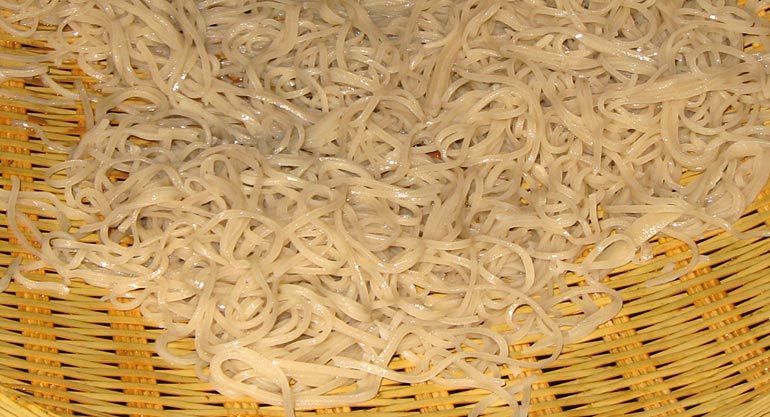- Yummy top
- Eateries and restaurants
- Uoyu - lunch restaurant
- Kanno
- Tokachiya
- Kitchen Nankai - Jinbocho
- Lamb Meat Tender
- Fujiyoshi - tempura restau.
- Enda - Japanese blue crab
- Fukuda - globefish pot
- Sugimoto
- Fuushi
- Soba restaurant
- Shinano - Akabanebashi
- Juwari-soba Inamuraya
- Ando and Korin
- Toranomon Sunaba
- Izakaya
- subLime and Kakinoki
- Donburi-bachi
- Renka
- Yoshida
- Daini-Chikarashuzo
- Sasagin
- Mugiya - soba izakaya
- Fukube
- Sasashin in Ningyo-cho
- Foreign cuisine
- Pizza Piazza
- Atelier de Fromage
- La Piccola Tavola
- Milieu - salad lunch
- Cafe Moskow - Spanish bar
- Sin Tong Kee
- Sekaihanten
- Miscellaneous
- Cheese & champignon party
- Natural Cheese Contest
- Donburi - rice bowl dish
- Home cooking
- Aji no nanban-zuke
- Spaghetti Carbonara
- Curry rice
Mugiya - soba izakaya

Mugiya at night.
 At least ten years long I am a regular customer of Mugiya. Why? Simply because Mugiya treats clients with good quality food and alcohol, attentive service and casual and relaxing atmosphere.
At least ten years long I am a regular customer of Mugiya. Why? Simply because Mugiya treats clients with good quality food and alcohol, attentive service and casual and relaxing atmosphere.Mugiya calls itself "soba-izakaya" - Japanese style bar with soba specialty. In fact, "Mugiya" means "buckwheat restaurant". Mugiya’s soba is extremely delicious with its special al-dente type texture and it is one of my most favorite soba in Tokyo. It reminds me of the best Issa-an style soba (*). Therefore, I was astonished to hear that Mugiya’s soba is home made, however, not hand made but machine made, though cooks are fond of Issa-an style and try to produce the taste of Issa-an. In spite that Mugiya’s soba is not hand made, I find it really tasteful. Should I then give up my pride as connoisseur of delicious foods?
- (*) Issa-an style of soba was established
by Yasuo Katakura (1904-1995). Katakura tried to reproduce the delicious soba his mother used to make at home. Already in the 1930s his restaurant in Omori received a high reputation. After the WWII he opened Issa-an in Ashikaga, Tochigi prefecture, and attracted not only numerous customers but also pupils.



From left clockwise: Dashimaki-tamago, Yakitori and Sashimi (three kinds of Hikarimono)
 Frankly speaking, I feel a bit uncomfortable to call her okami or okami-san, because this old fashioned word does not fit a modern and urbane woman like her. But, okami is Yui-san's official title in Mugiya.
Frankly speaking, I feel a bit uncomfortable to call her okami or okami-san, because this old fashioned word does not fit a modern and urbane woman like her. But, okami is Yui-san's official title in Mugiya.
- (**)
- The word "okami" is usually used to call female general manager of a traditional Japanese inn or restaurant. We have a fixed image of okami and believe that okami behaves elegantly in kimono and embodies tradition in the service sector.
 I should not fail to mention the earthenware of Mugiya. They are all made by a pottery in the old Sueki style in anagama (hole kiln) on the specific order by Mugiya. Their archaic expression is a part of deliciousness of food and charm of Mugiya's interior.
I should not fail to mention the earthenware of Mugiya. They are all made by a pottery in the old Sueki style in anagama (hole kiln) on the specific order by Mugiya. Their archaic expression is a part of deliciousness of food and charm of Mugiya's interior.There are various seating possibilities in Mugiya: several ordinary tables, counter seats, tatami space with horigotatu (***) and a couple of separate rooms for two to 10 persons. Usually I choose tatami seats and occasionally a small separate room with terracotta wall and African(!) ornaments. The latter exists slightly distant from the main space and we can feel there as if we are in a hideout.
- (***)
- "Horigotatsu" means a charcoal heater built into the floor. Of course, during the summer time, there is no heating. But, the space for feet is comfortable for those who are not accustomed to sitting on the floor.

